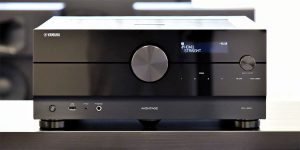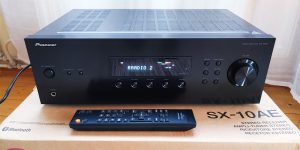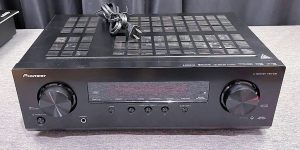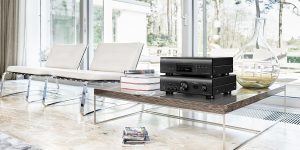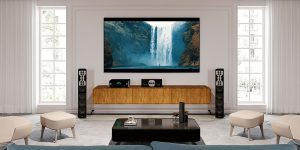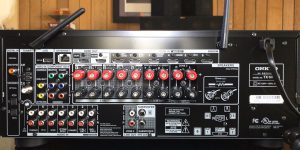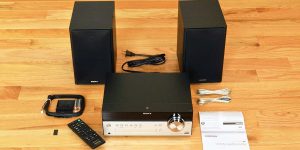For this review, I thought it would be interesting to consider the Denon vs. Yamaha confrontation, as both brands are incredibly popular among users. Not surprisingly, those buying a receiver for the first time or considering upgrading their outdated system have doubts. For the most objective approach, I will start with a brief history of each brand, explain the general differences in the products’ sound, and then compare receivers closest to each other in terms of their characteristics, emphasizing their specific differences. This way, you will be able to make an informed decision and choose in favor of one of the participants in this “confrontation”.
Brief history of Denon
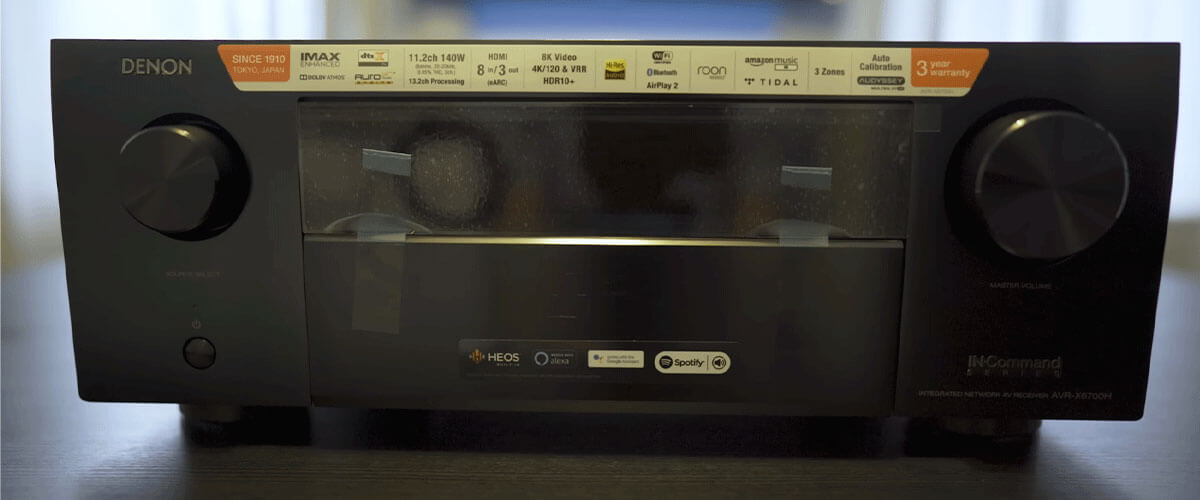
The Japanese brand started with the production of gramophones back in 1910. But then, the company, founded by American Frederick Whitney Horne, was called Nippon Chikuonki Shoukai (Japan Recorders Corporation). The brand was named Denon in 1930, short for “Denon Onkyo”.
For more than 100 years of its existence, the manufacturer was at the origin of introducing new technologies in the sound field. For example, in 1939, the first professional disk recorder was released; in 1970 – the first PCM recorder; and in the 2000s, they were the first to introduce Dolby Digital surround sound for AV receivers.
If you would like to take a closer look at Denon’s interesting and rich experience and reputation, which today guarantees quality and compliance with modern requirements, please follow this link.
Brief history of Yamaha
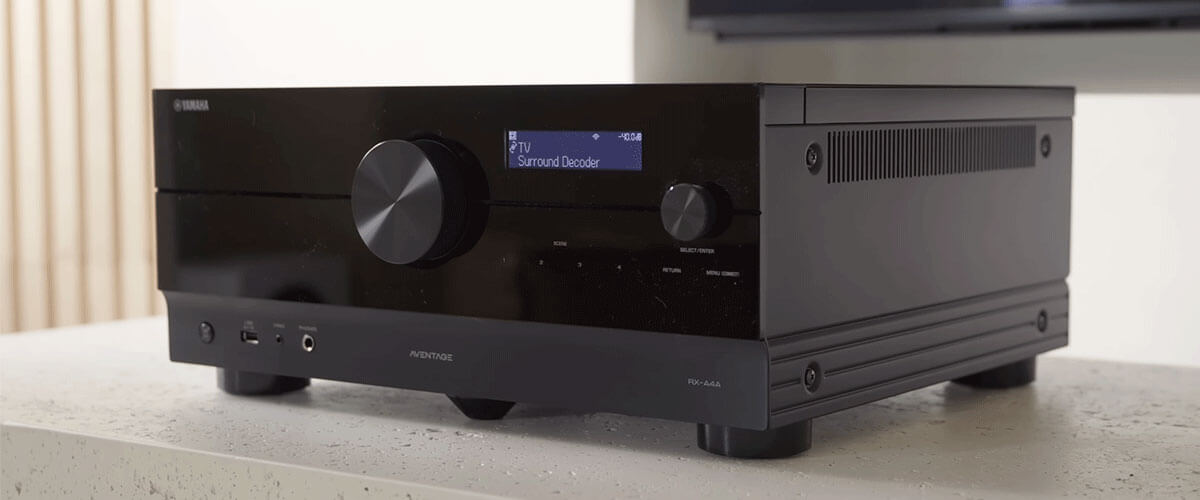
The history of this brand is no less interesting. The company “Nippon Gakki Co. Ltd”, officially founded by Japanese Torakusu Yamaha in 1887, who accidentally encountered a reed organ, today has worldwide popularity.
The Yamaha brand received its name after the founder’s death, after celebrating his 100th birthday. Having started with the production of gramophones in the 20s, by the end of the 1970s, the brand was already leading in the field of amplifiers. In the 90’s, the company made a breakthrough in producing receivers for home theaters.
The company’s lineup is amazing, as it produces equipment for various purposes and develops its own unique technologies but always maintains a quality that meets modern standards. Their most popular line of AV receivers today, the Aventage, is worth a look.
For a more in-depth look at the history of Yamaha, follow this link.
General sound differences between Denon and Yamaha receivers
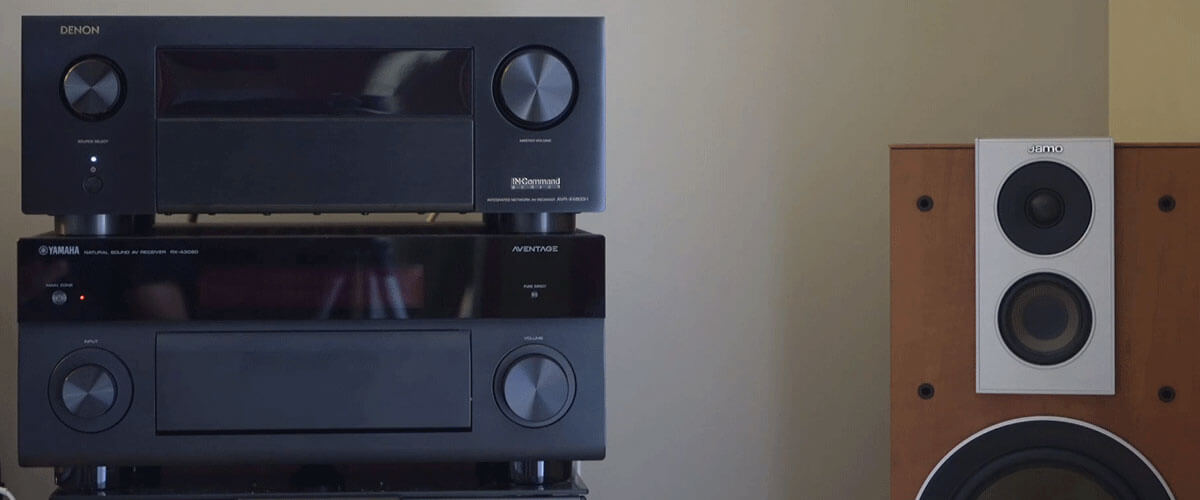
It is impossible to distinguish any general, pronounced sound differences between Yamaha vs. Denon’s sound quality because they will largely depend on your additional equipment (sound source, speakers, room, etc.).
Nevertheless, some users note that Yamaha receivers have a more neutral sound character, I would even say – characteristic coldness and Denon receivers have a warmer and more relaxed sound. This is due to the DAC chips and amplifier circuits used in them. So, in some “average listening scenario” in stereo mode, Yamaha will win, while Denon performs better in multi-channel mode and for vinyl. But the general rule, according to which it is considered that the sound of receivers of the same price category will be practically indistinguishable (with proper tuning/calibration), works for these two brands.
Also, the room correction system is worth mentioning separately. It’s generally accepted that the Yamaha YPAO loses out to Denon’s more adaptive Audyssey. But I would say that this is more a matter of taste.
In terms of “reliability” of operation, users note the stable operation of models of both brands. Indeed, the quality of the parts used in production is at about the same high level.
Let’s assume you’re ultimately choosing between brands, not specific models. So, I would recommend choosing Denon or Yamaha based on aesthetics, desired receiver capabilities and under your particular budget.
Our criteria for choosing Denon and Yamaha receivers for comparison
For this comparative review, I tried to choose the best models for different purposes and tasks in different price segments. And my criteria were the following factors:
- Listening experience.
- Availability of necessary built-in features (support for modern video technologies, surround sound formats, Bluetooth, Ethernet/Wi-Fi/streaming services, etc.).
- A sufficient number of input and output connections.
- Price.
Mid-priced Denon and Yamaha AVRs comparison
Denon AVR-X3800H vs Yamaha RX-A6A
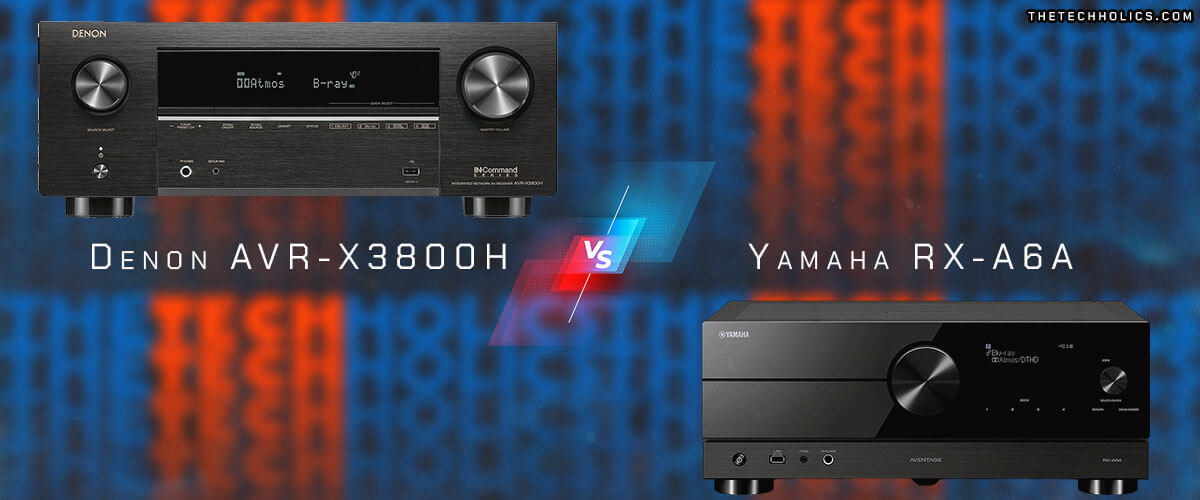
Honestly, for me, there is no such thing as Yamaha vs. Denon. As you’ve already realized, for me, the objective evaluation is to compare specific models. Yes, these receivers are 9-channel, and since they were released relatively recently (AVR-X3800H in 2022 and RX-A6A in 2021), they have modern audio and video features. But they are very different, starting from the appearance, weight (27.6 kg AVR-X3800H vs. 41.2 kg RX-A6A), price (Denon is an order of magnitude cheaper), and ending… but more about that, perhaps.
Both receivers can be expanded to a system with 11 channels, but Denon has 4 independent outputs for subwoofers (Yamaha has only 2). At the same time, the AVR-X3800H is inferior to the RX-A6A in terms of power, providing 105 watts (8 ohms, 20 Hz – 20 kHz, 2 ch) and broadcasting sound to 2 zones versus 150 watts (8 ohms, 20 Hz – 20 kHz, 2 ch) when broadcasting sound to 4 zones.
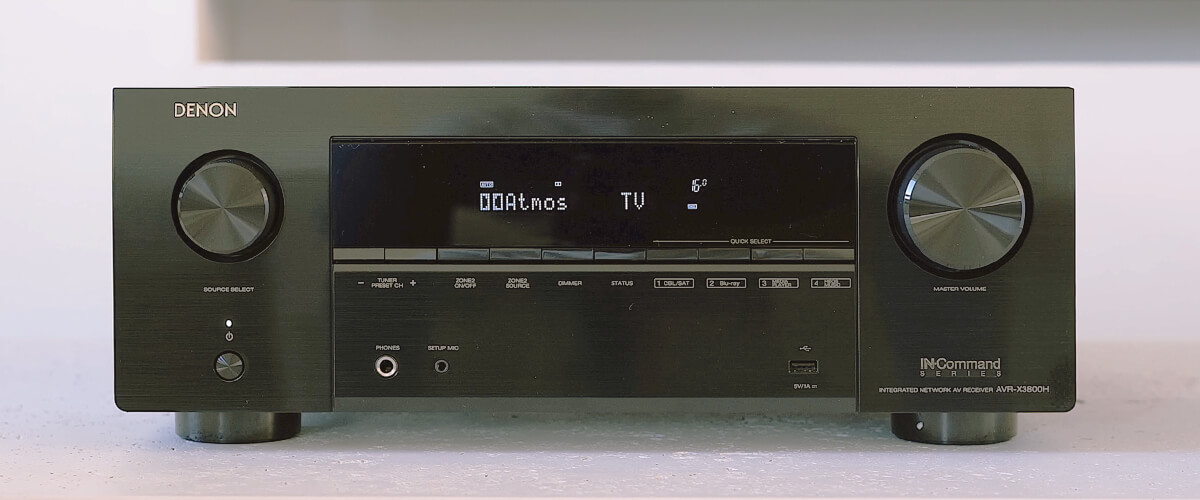
Denon can upscale video to 8K resolution, while Yamaha can only upscale to 4K. At the same time, the RX-A6A has 7 HDMI 2.1, while the AVR-X3800H has only 6. Also, Yamaha, unlike Denon, does not support Dynamic HDR format with contrast enhancement, but it has the function of converting analog signal to digital (HDMI Upconversion).
The companies have been developing their unique systems for decades, and both have their well-wishers and enemies. But the RX-A6A uses Surround:AI, which I recommend you familiarize yourself with.
Of the features, I would also mention the IMAX Enhanced certification for the Denon AVR-X3800H. Highly recognized, denoting premium membership.
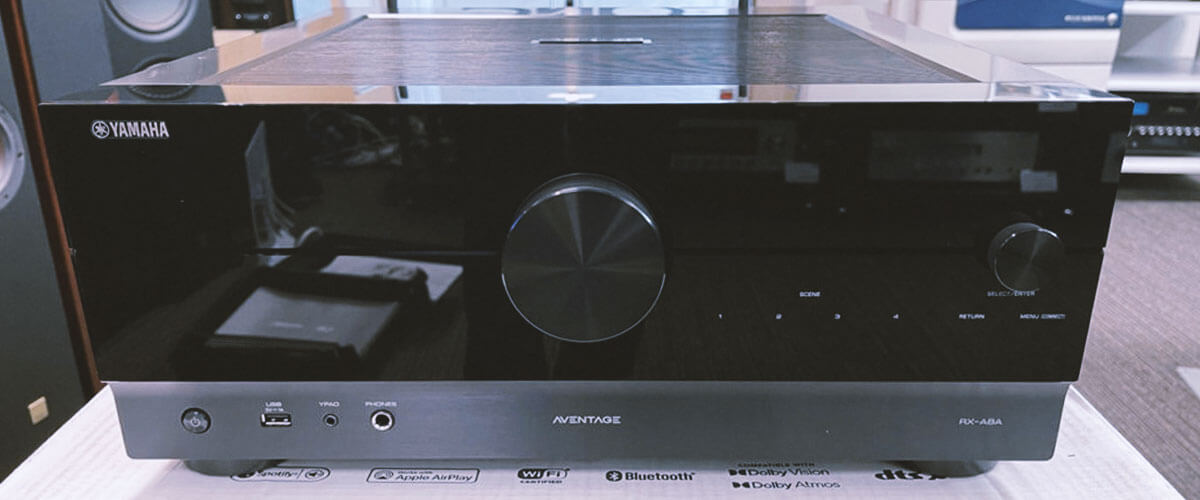
My heart belongs to Denon; I’m not going to lie. While I can’t help but appreciate the build quality and implementation of technology in the RX-A6A, it’s certainly a great unit that’s worth its money.
But I’ve gotten carried away; it’s time to move on.
Denon AVR-X3800 key specs
- Channels: 9.4.
- Power output: 105W/8 Ohm, 135W/6 Ohm.
- HDMI inputs/outputs: 6/3.
- Video functions: 8K/60Hz, 4K/120Hz pass-though, upscaling up to 8K.
- Bluetooth/Wi-Fi: yes/yes.
- Streaming services: AirPlay 2, Spotify, TuneIn, Deezer, Tidal, Netflix, Amazon Prime.
- Supports: HDMI ARC, HDMI eARC, HDMI CEC, HDCP2.3, HDR10+, Dolby Vision.
- Surround sound: DTS:X, DTS Neural:X, DTS Virtual:X, Dolby Atmos, DTS HD Master, Dolby TrueHD, Dolby Atmos Height Virtualization, Dolby Atmos Music, Auro 3D.
Yamaha RX-A6A key specs
- Channels: 9.2.
- Power output: 150W/8 Ohm.
- HDMI inputs/outputs: 7/3.
- Video functions: 8K/60Hz, 4K/120Hz, 4K/60Hz pass-through, video upconversion (up to 1080p and 8K) for analog and HDMI sources.
- Bluetooth/Wi-Fi: yes/yes.
- Streaming services: AirPlay2, Deezer, Tidal, Pandora, SiriusXM, Napster, SoundCloud, Amazon Music, Amazon Music HD, Mood mix.
- Supports: HDMI ARC, HDMI eARC, HDMI CEC, HDCP2.3, HDR10, HDR10+, Dolby Vision.
- Surround sound: DTS HD Master, DTS Neural:X, Dolby TrueHD, Dolby Surround, Dolby Digital Plus, Dolby Atmos Height Virtualization, Dolby Atmos, Auro-3D
Denon AVR-X3800H
Yamaha RX-A6A
Premium Denon and Yamaha AVRs comparison
Denon AVR-X6700H vs Yamaha RX-A8A
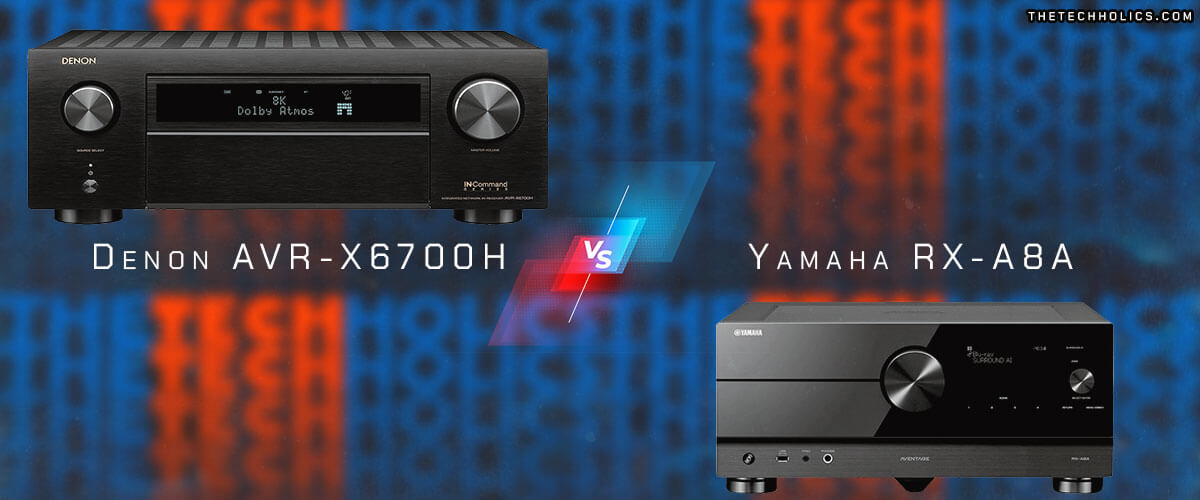
Things are a bit simpler with this pair of premium models from both brands. That’s for two reasons: many differences (appearance, wireless multi-room audio system, calibration system, technologies) have already been specified for the first pair of this review and are generally standard as differences in the specifics of the two brands. In video and surround sound, AVR-X6700H, and RX-A8A are almost identical and have the same price. So, this mini-review of Denon versus Yamaha will determine your preference for the factors I describe below.
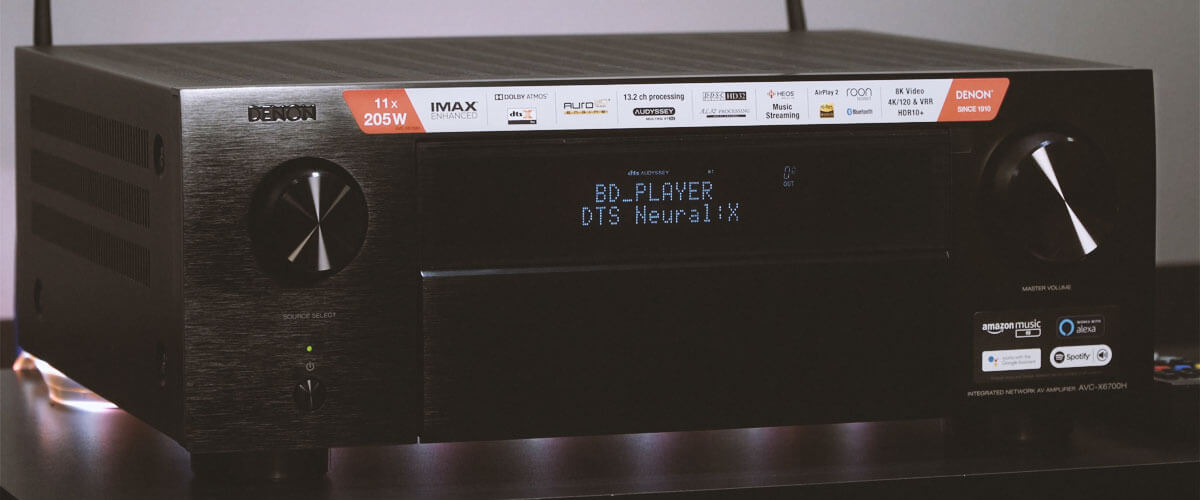
So we have before us the AVR-X6700H (2020 model year) and Yamaha RX-A8A (2021 model year) 11.2-channel AV receivers. But you can expand the Denon to a 13-channel system, although it’s a bit less powerful (140W vs. 150W for the Yamaha). But for such systems, the 10W difference is insignificant, especially since, as mentioned earlier, the Denon has a warmer sound and the Yamaha has a cooler sound. You won’t realize the power difference even listening to them one after the other.
In the area of connectivity, the AVR-X6700H is also ahead, as it has at least 1 more of almost every type of connector (including HDMI). It scales video up to 8K, while the Yamaha only scales to 4K.
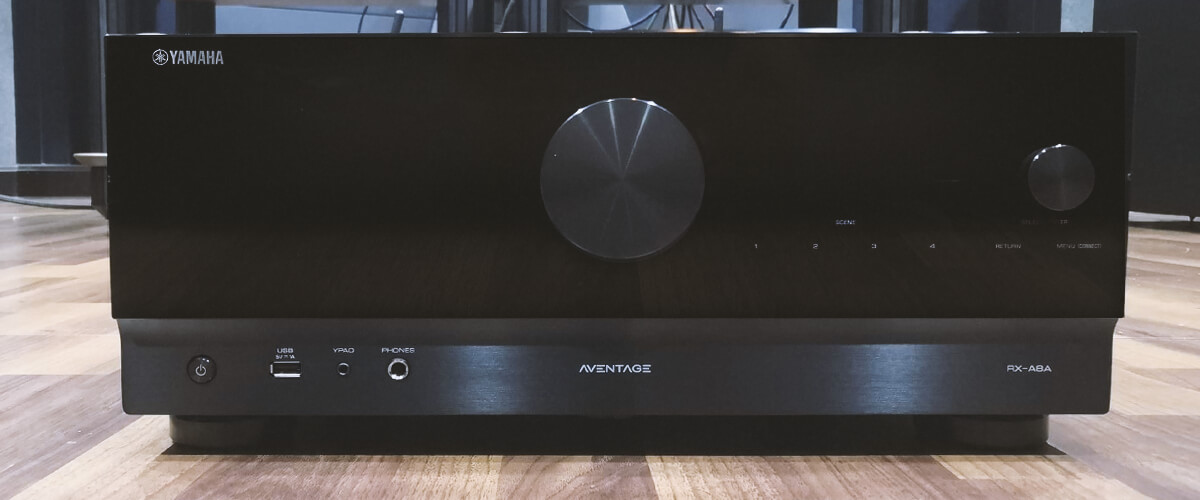
In the field of audio, Yamaha provides support for higher-resolution Music Playback via USB and signal broadcasting to 4 zones (Denon has 3). The formats of surround sound decoding are identical, but without using the upper channels with AVR-X6700H, you can build a 9.2 system, and with Yamaha, only 5.2 and 7.2.
In general, I leave the choice to your taste, and I can assert that both devices deserve your attention and respect.
Denon AVR-X6700H key specs
- Channels: 11.2.
- Power output: 140W/8 Ohm, 175W/6 Ohm.
- HDMI inputs/outputs: 7/3.
- Video functions: 8K/60Hz, 4K/120Hz pass-though, upscaling up to 8K.
- Bluetooth/Wi-Fi: yes/yes.
- Streaming services: AirPlay 2, Spotify, TuneIn, Deezer, Tidal, Netflix, Amazon Prime.
- Supports: HDMI ARC, HDMI eARC, HDMI CEC, HDCP2.3, HDR10+, Dolby Vision.
- Surround sound: DTS:X, DTS Neural:X, DTS Virtual:X, Dolby Atmos, DTS HD Master, Dolby TrueHD, Dolby Atmos Height Virtualization, Dolby Atmos Music, Auro 3D.
Yamaha RX-A8A key specs
- Channels: 11.2.
- Power output: 150W/8 Ohm.
- HDMI inputs/outputs: 7/3.
- Video functions: 8K/60Hz, 4K/120Hz, upscaling up to 8K.
- Bluetooth/Wi-Fi: yes/yes.
- Streaming services: AirPlay 2, Spotify, TuneIn, Deezer, Tidal, Netflix, Amazon Prime.
- Supports: HDMI ARC, HDMI eARC, HDMI CEC, HDCP2.3, HDR10+, Dolby Vision.
- Surround sound: DTS:X, DTS Virtual:X, Dolby Atmos, DTS HD Master, Dolby TrueHD, Auro 3D.
Denon AVR-X6700H
Yamaha RX-A8A
Budget Denon and Yamaha AVRs comparison
Denon AVR-S660H vs Yamaha RX-V385
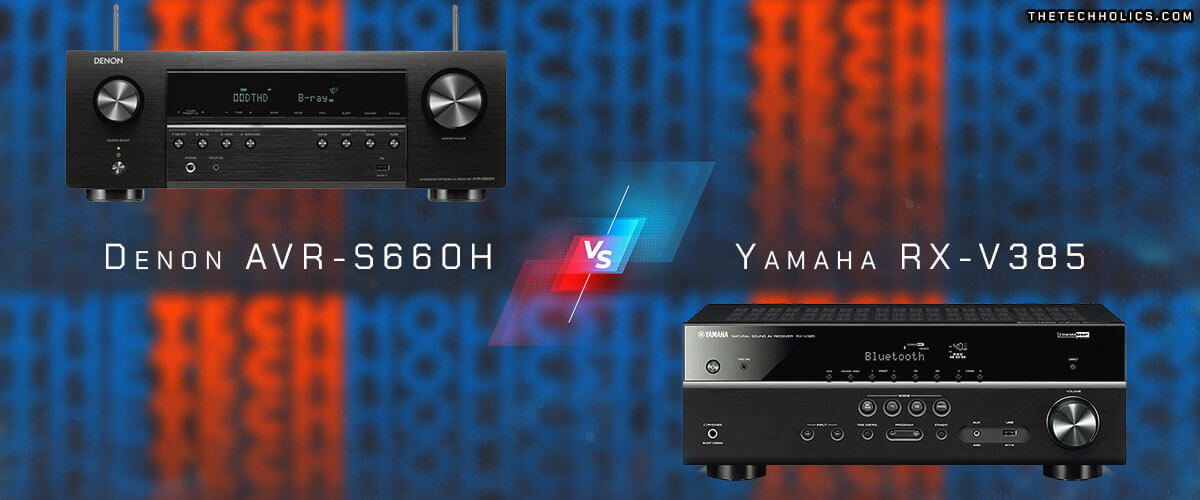
These babies will appeal to those who want a reliable receiver with minimal features at a budget price (Denon is slightly more expensive). But while both 5-channel AVRs have similar specs, features, and costs, the AVR-S660H released in 2021 has a bit more to offer than the 2018 RX-V385.
Since the Yamaha is older and saw the light of day before 2021 HDMI 2.1, it makes perfect sense that it doesn’t have that connector (only 4/1 ports). Accordingly, it can offer video at a maximum resolution of 4K, whereas 3 of the 6 HDMIs on the Denon will allow you to stream 8K video. Otherwise, they are plus or minus similar in terms of connections.
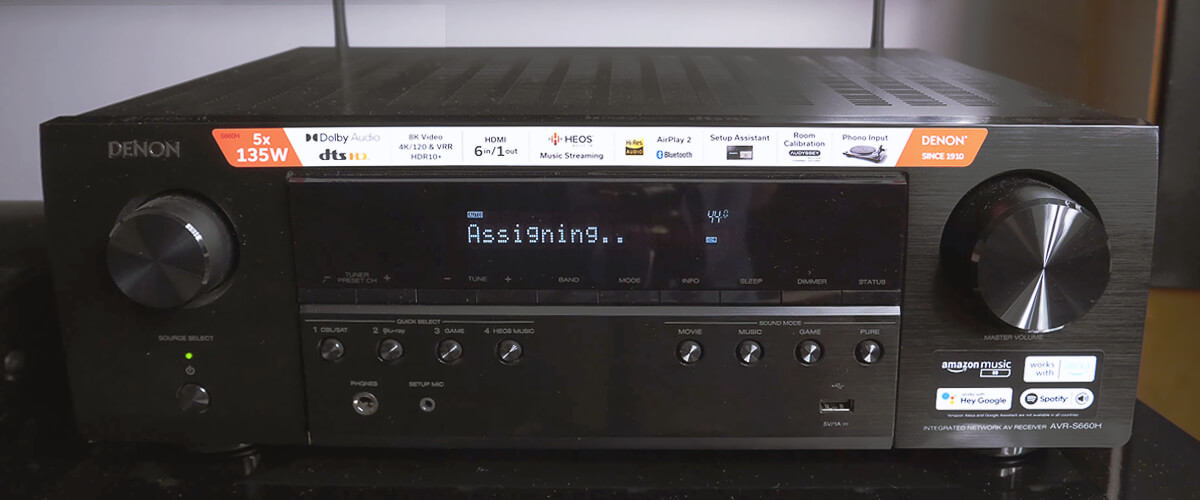
Wireless connectivity is also different, as the RX-V385 doesn’t have Wi-Fi. But its Bluetooth has a Music Enhancer feature, which does help you get decent results in broadcasting a signal from a smartphone. However, the Denon is compatible with some streaming services (even Roon Tested) voice assistants (including Josh), has a built-in multi-room HEOS system, works with AirPlay 2, and is compatible with Apple devices.
When it comes to surround sound, Denon vs. Yamaha receivers are not competitors. Yes, they have different powers, 75 W (0.08% THD) vs. 70 W (0.09% THD), but both sound great at maximum, clear and interference-free, which is rare for devices in this category. Yamaha has exclusive CINEMA DSP technology, making the soundstage a bit brighter and fuller with the halftones inherent in Bottom Line, Roxy Theater, and European cathedrals
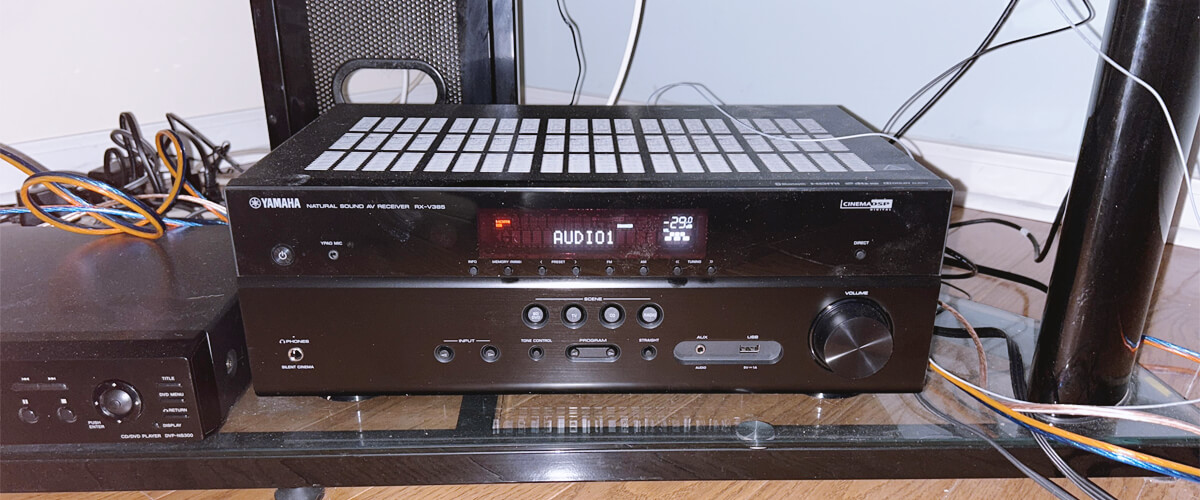
Whatever you decide, favor the model that meets your requirements. It’s not the design or the year of manufacture that should influence your choice, but the experience of watching movies and listening to music.
Denon AVR-S660H key specs
- Channels: 5.2.
- Power output: 75W/8 Ohm.
- HDMI inputs/outputs: 6/1.
- Video functions: 8K/60Hz, 4K/120Hz pass-though, upscaling up to 8K.
- Bluetooth/Wi-Fi: yes/yes.
- Streaming services: AirPlay 2, Spotify, TuneIn, Deezer, Tidal, Netflix, Amazon Prime.
- Supports: HDMI ARC, HDMI eARC, HDMI CEC, HDCP2.3, HDR10+, Dolby Vision.
- Surround sound: DTS HD Master, DTS:X, DTS Virtual:X, Dolby Atmos, Dolby TrueHD.
Yamaha RX-V385 key specs
- Channels: 5.1.
- Power output: 70W/8 Ohm.
- HDMI inputs/outputs: 4/1.
- Video functions: 4K/60Hz pass-through, upscaling up to 4K.
- Bluetooth/Wi-Fi: yes/no.
- Streaming services: has not.
- Supports: HDMI ARC, HDMI eARC, HDMI CEC, HDCP2.3, HDR10+, Dolby Vision.
- Surround sound: Dolby Digital Plus, DTS HD Master, Dolby TrueHD.
Denon AVR-S660H
Yamaha RX-V385
Stereo Denon and Yamaha receivers comparison
Denon DRA-800H vs Yamaha R-N303
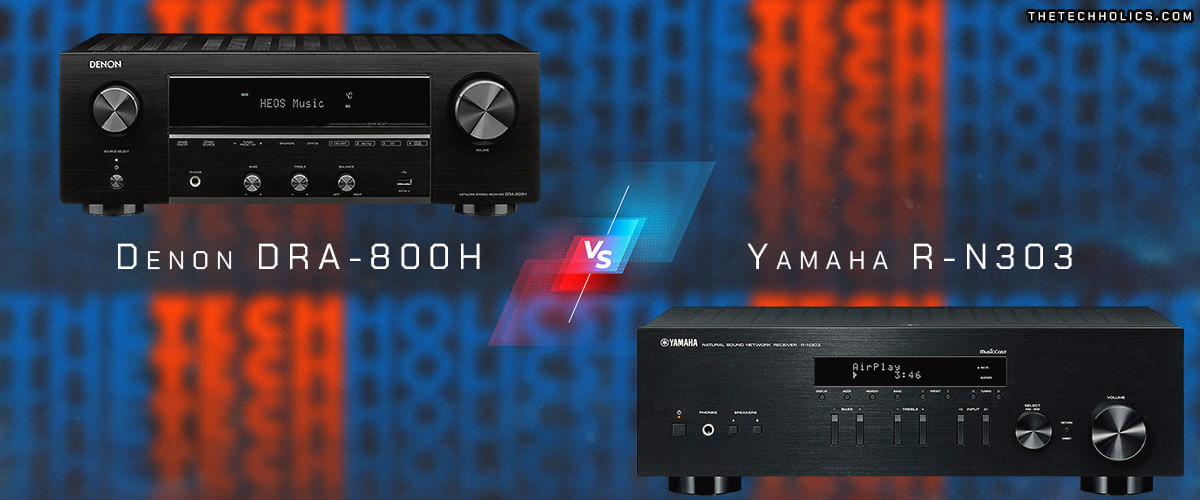
The two-channel Denon DRA-800H and Yamaha R-N303 were released in 2029 and 2017, respectively, but are still great basics for your stereo systems, even though the Denon is twice the price.
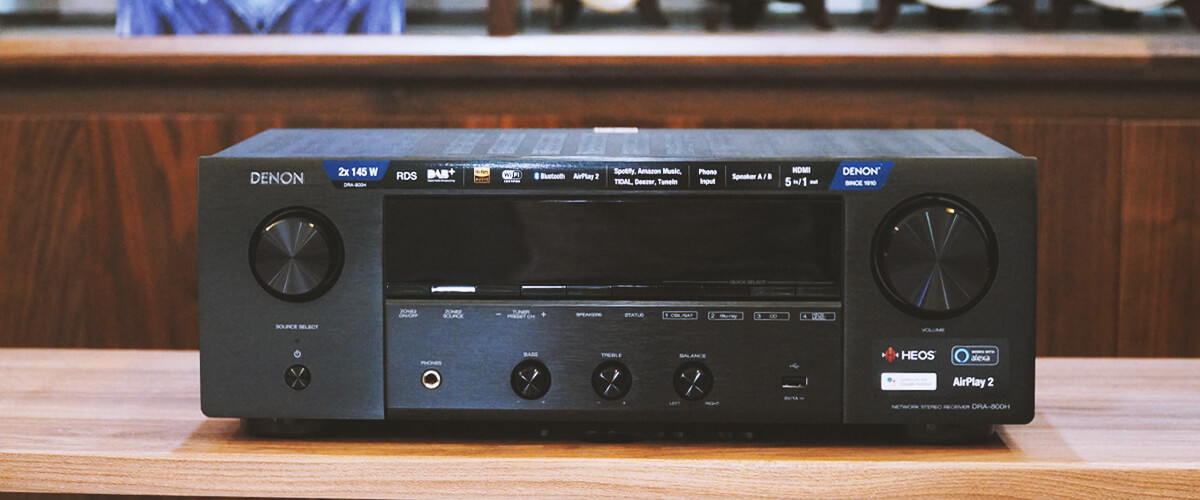
Why? Well, if only because the DRA-800H has 5 HDMI ports with 4K video streaming. At the same time, the Yamaha R-N303 is created exclusively for music lovers and has nothing to do with movies, although it will certainly significantly improve your TV’s sound.
In terms of wireless connectivity and music capabilities, however, these are great entry-level stereo receivers for non-professional home use. Both support and are compatible with many streaming services, have built-in ecosystems, and work with Hi-Res audio.
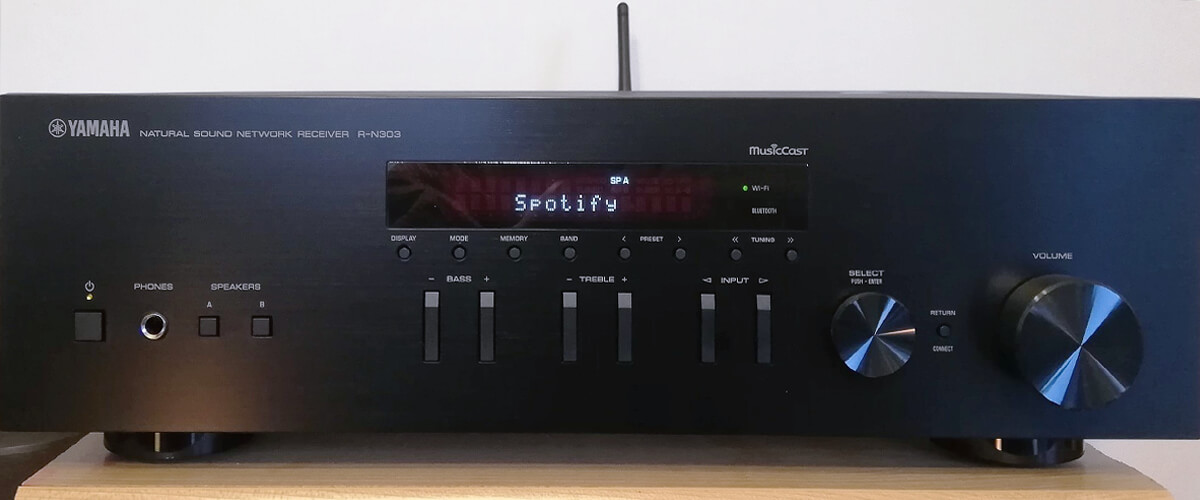
Whether you want to listen to records or digital music from streaming services or your smartphone, the Denon DRA-800H and Yamaha R-N303 will do the job just fine. And since there are no dramatic differences between them, I suggest just studying the specifications of each stereo receiver.
Denon DRA-800H key specs
- Channels: 2.2.
- Power output: 100W/8 Ohm, 120W/6 Ohm.
- HDMI inputs/outputs: 5/1.
- Video functions: 4K/60Hz pass-through.
- Bluetooth/Wi-Fi: yes/yes.
- Streaming services: AirPlay2, Deezer, Tidal, Pandora, SiriusXM, Napster, SoundCloud, Amazon Music, Amazon Music HD, Mood mix.
- Supports: HDMI CEC, HDCP2.3, HLG.
- Surround sound: has not.
Yamaha R-N303 key specs
- Channels: 2.0.
- Power output: 140W/8 Ohm.
- HDMI inputs/outputs: 0/0.
- Video functions: has not.
- Bluetooth/Wi-Fi: yes/yes.
- Streaming services: Pandora, Napster, Spotify, SiriusXM Internet Radio, TIDAL, Deezer.
- Surround sound: has not.
Denon DRA-800H
Yamaha R-N303
FAQ
How user-friendly are the interfaces for each?
How reliable are Denon and Yamaha AV receivers?
Do these brands support the latest video standards like 4K, 8K, and HDR?
We are supported by our audience. When you purchase through links on our site, we may earn an affiliate commission at no extra cost to you.
Our newsletter
* We will never send you spam or share your email with third parties

![Best Budget Receivers [Reviewed and Tested]](https://thetechholics.com/wp-content/uploads/2023/10/best-budget-av-receiver-300x150.jpg)
![Best 9-Channels AV Receivers [Reviewed and Tested]](https://thetechholics.com/wp-content/uploads/2023/10/best-9-2-receiver-300x150.jpg)

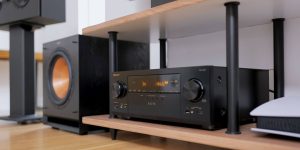
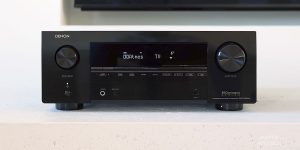
![Pioneer vs Denon Receivers [Top Models Compared and Tested]](https://thetechholics.com/wp-content/uploads/2023/10/denon-vs-pioneer-review-300x150.jpg)
